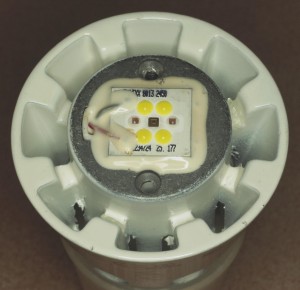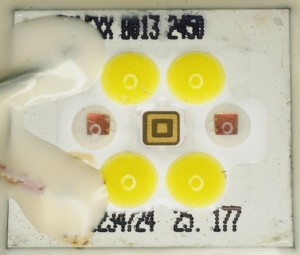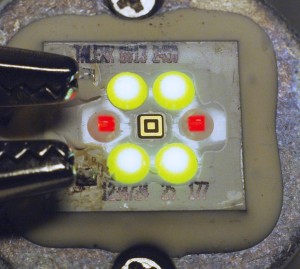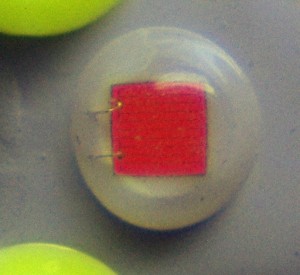[:en]At least the best one I have seen so far. After giving a lecture on LEDs yesterday I finally unpacked and tested my latest buy – the clear E27 LED bulb LEDARE from IKEA.

(Image linked from IKEA’s homepage.)
The specs of this LED bulb are not overly impressive, with an efficacy of a mere 50 lm/W it is about as efficient as a compact fluorescent lamp and with its 400 lm it corresponds to a 30 W to 40 W light bulb. Running at 8.1 W this means that it will consume only 20-25% of the electricity of a comparable incandescent bulb.
But what really amazed me was the high quality of the light. It is a nice warm white, stated as 2700 K on the package, much comparable to the best compact fluorescents I have seen and close to an incandescent – if this is what you are after. Not only is the visual impression of the light very good, also the color rendering is very good.
| socket | E27 |
|---|---|
| size | 59 mm diameter, 119 mm length |
| voltage | 220 V – 240 V |
| power | 8.1 W |
| output | 400 lm |
| color temperature | 2700 K |
| CRI | > 85 |
| lifetime | 20000 h |
| on/off switching | 100000 |
| manufactured in | India |
| price | SEK 99 (EUR 12, Nov. 2012) |
So, how does IKEA accomplish the pleasant spectral composition of the light bulb? I taught my students that the best way to do this is by using the correct blend of phosphors, like in compact fluorescents. But then there was a distinct red appearance when I looked closely at the LED bulb. The LEDs themselves are hidden underneath a light-spreading plastics cone inside the clear glass dome of the bulb – interestingly this cone is screwed to the bulb, not glued as you might expect.

However, the glass dome itself is glued to the solid metal lamp socket which serves as heat sink for the internal converter and the LEDs themselves. I was not able to remove it without breaking, but the rest of the bulb remained undamaged. So how does it look under the hood?

The solid cast metal socket carries a COB (chip-on-board) unit with 6 LEDs:
- four white LEDs, being standard blue LEDs with a phosphor-containing blob of resin on top
- and two big red-emitting LEDs in between.

The LED chips are connected in a string with a voltage drop of 16.5 V. One interesting fact about the red LEDs is that there are two bond wires from the board to the front side of the LED chip.


A short inquiry on the internet revealed that the COB module is made by the company Tridonic. More information can be found on their homepage.[:sv]I alla fall den bästa jag har sett hittills. Efter min föreläsning om lysdioder igår öppnade jag äntligen förpackningen till mitt senaste fynd – en klar E27 lysdiodslampa LEDARE från IKEA.

(Bilden är länkad från IKEAs hemsida.)
Lysdiodslampans specifikationer är inte nånting utomordentligt längre idag. Med ett ljusutbyte på 50 lm/W är den ungefär lika effektiv som en lågenergilampa av lysrörstyp och med 400 lm motsvarar den en 30 W till 40 W glödlampa. Med en elektrisk effekt på 8.1 W kommer den bara förbruka 20-25% jämfört med en vanlig glödlampa.
Men det som jag upplevde som speciellt med denna lampa var den höga kvaliten av själva ljuset. Inte det kalla, blå skenet som många fortfarande förknipar med lysdioder, men ett angenämt varmt sken, enligt förpackningen ska det motsvara en färgtemperatur på 2700 K. Den liknar de bästa lågenergilamporna och även glödlamporna – om det nu är det man vill ha. Men inte bara dess direkta sken är bra, även färgåtergivningen är mycket bra.
| sockel | E27 |
|---|---|
| storlek | diameter 59 mm, längd 119 mm |
| spänning | 220 V – 240 V |
| effekt | 8.1 W |
| ljusstyrka | 400 lm |
| färgtemperatur | 2700 K |
| CRI | > 85 |
| livslängd | 20000 h |
| på/avslagningar | 100000 |
| tillverkad i | Indien |
| pris | SEK 99 (EUR 12, Nov. 2012) |
Frågan är hur IKEA lyckats att ta fram den här spektrala sammansättnignen av ljuset? Jag hade just berättat för mina studenter att den enklaste vägen är att använda rätt blandning av olika fluorescerande material, som i ett lysrör. Men LEDAREn hade ett märkligt rött sken när jag tittade närmare. Själva lysdioderna är gömda under en plastkon som ska sprida ljuset – märkligt nog är denna kon skruvat fast i lampans hölje, inte limmat som man kanske hade förväntat sig.

Själva glaskolven är däremot limmat till metallsockeln som samtidigt fungerar som kylfläns för lysdioderna och spänningsomvandlaren i sockeln. Den gick sönder när jag försökte ta bort den. Men hur ser det nu ut inuti lampan?

Den massiva, gjutna metallsockeln bär en sk COB (chip-on-board) enhet med 6 lysdioder:
- fyra vita lysdioder bestående av blå lysdioder täckt med en droppe harts eller plast innehållande det fluorescerande ämnet
- och två stora röd-emitterande lysdioder däremellan.

Lysdioderna är kopplade i en seriesträng som drivs med en spänning på 16,5 V. Intressant är att det röda chipset är ansluten med två bondtrådar på framsidan.


En kort sökning på nätet visade att COB-modulen tillverkas av företaget Tridonic. Mera information finns på deras hemsida.[:de]Zumindest wohl die beste, die ich bisher gesehen habe. Nach dem ich gestern eine Vorlesung über Leuchtdioden gehalten habe, bin ich endlich dazu gekommen, meine neueste Anschaffung auf diesem Gebiet auszupacken und zu testen: die klare LED-Lampe LEDARE mit E27-Sockel von IKEA.

(Bild direkt eingebunden von IKEAs Homepage.)
Die Spezifikationen dieser LED-Lampe sind heutzutage nichts herausragendes mehr. Bei einer Lichtausbeute von nur 50 lm/W ist die Lampe direkt vergleichbar mit einer Energiesparlampe mit Leuchtstoffröhre, und die 400 lm entsprechen einer 30 W bis 40 W Glühbirne. Mit einem Anschlußleistung von 8,1 W bedeutet dies einen Verbrauch von nur 20-25% verglichen mit einer Glühbirne.
Was mich aber wirklich positiv an dieser Lmape überrascht hat, ist die optische Qualität des Lichtes. Es hat einen angenehmen warmen Ton, auf der Verpackung angegeben als Farbtemperatur von 2700 K, vergleichbar mit den besten Energiesparlampen und mti einer Glühlampe – wennes das ist, was man haben will. Aber nicht nur der Eindruck des direkten Lichtes ist positiv, auch die Farbwiedergabe im Licht dieser Lampe ist ausgezeichnet.
| Sockel | E27 |
|---|---|
| Abmessungen | 59 mm Durchmesser, 119 mm Länge |
| Spannung | 220 V – 240 V |
| Leistung | 8,1 W |
| Lichtstrom | 400 lm |
| Farbtemperatur | 2700 K |
| CRI | > 85 |
| Lebensdauer | 20000 h |
| Schaltvorgänge | 100000 |
| hergestellt in | Indien |
| Preis | SEK 99 (EUR 12, Nov. 2012) |
Wie also bekommt IKEA die spektrale Zusammensetzung dieses Lichtes hin? Gerade hatte ich meinen Studenten erklärt, daß es am einfachsten und besten sei, die Zusammensetzung des fluoreszierenden Materials anzupassen, wie dies auch in Leuchtstoffröhren gemacht wird. Aber bei genauerem Hinsehen glaubte ich enen speziellen roten Schein an dieser LED-Lampe zu sehen. Die eigentlichen Leuchtdioden sind unter einem lichtstreunenden Plastikkegel in der Mitte des Glaskolbens versteckt – erstaunlicherweise ist dieser Plastikkegel mit dem Metallsockel verschraubt und nicht verklebt.

Verklebt dagegen ist der Glaskolben mit dem Metallsockel, und es gelang mir nicht, diesen unbeschadet zu entfernen. Aber was steckt jetzt wirklich unter der Haube?

Der gegossene Metallsockel trägt auf der Oberseite in COB-Modul (chip-on-board) mit 6 erkennbaren Leuchtdioden:
- vier weiße LEDs, in der Standardform mit einem Tropfen Plastikmasse mit eingebettetem Leuchtstoff über einer blauen Leuchtdiode
- und dazwischen zwei große, rotleuchtende LEDs.

Diese Leuchtdioden sind in einem Strangen in Reihe geschaltet, und werden bei einer Spannung von 16,5 V betrieben. Die Chips der roten Leuchtdioden sind übrigens mit zwei Drähten auf der Oberseite kontaktiert.


Eine kurze Recherche im Internet hat ergeben, daß das COB-Modul von der Firma Tridonic stammt. Mehr Informationen gibt es auf deren Homepage.[:]
![[:en]GreenPhotons [:sv]GreenPhotons – gröna fotoner[:de]GreenPhotons – grüne Photonen[:]](https://www.sciencetronics.com/greenphotons/wp-content/uploads/2025/02/header.jpg)
![You are currently viewing [:en]The best LED bulb?[:sv]Den hittills bästa LED-lampan?[:de]Die beste LED-Lampe?[:]](https://www.sciencetronics.com/greenphotons/wp-content/uploads/2012/11/IGP7994a_900.jpg)
![Read more about the article [:en]Time for a new power tool[:sv]Tid för ett nytt elverktyg[:de]Zeit für ein neues Elektrowerkzeug[:]](https://www.sciencetronics.com/greenphotons/wp-content/uploads/2013/07/IMGP1184a_900-300x171.jpg)
Pingback: The best LED bulb? – part 2 « GreenPhotons
Thanks a lot for sharing your experience.
I’ve bought this bulb and it appears it is a little taller than standard/incandescent E27 bulbs, thus not fitting into my wall light;
I was able to remove the glass dome of the bulb with a bicycle inner-tube (chambre a air), surrounding the bulb like a big elastic , in order to distribute my pressure equally on the glass surface.
Now with the glass dome removed the bulb is a little shorter than incandescent e27 and it fits everywhere.
Hope this helps anyone who wants to remove the glass cleanly.
Thanks for this tip!
Indeed I also had trouble removing the glass dome when inspecting the interior of the bulb – I ended up with a lot of small pieces of glass.
Uwe.
Thanks for the LED teardown, very interesting.
The Tridonic link doesn’t work anymore, what TALEXX model number is it, I coudln’t find it at their website? Is it a custom model not shown at their website?
It appears to be a custom model, but it is very similar to the ones shown on their website. I changed the broken link to point just to the Tridonic homepage
Very interesting article indeed.
I have recently (may 2014) purchased one of the newest IKEA LEDARE bulbs, a 16.5W model boasting 1,000 lumens. It is quite cumbersome, but the intensity and quality of light is stunning. I suspect they use the same trick (mostly white LEDs and a few red LEDs) to even out the color spectrum (they say the CRI to be over 87!). I just have some concern about heat management: no fins, just the ceramic body to extract calories.
If anybody has a go at this model, I would be most interested to know how it is constructed…
I haven’t seen these here in Sweden yet – once I get hold of one, I’ll have a look under the hood.
Now I have purchased and opened one of these 1000 lm giants. See my latest post (2014-06-11).
Pingback: IKEA Ledare 600 Lumen LED Light Bulb Review | Since 1989